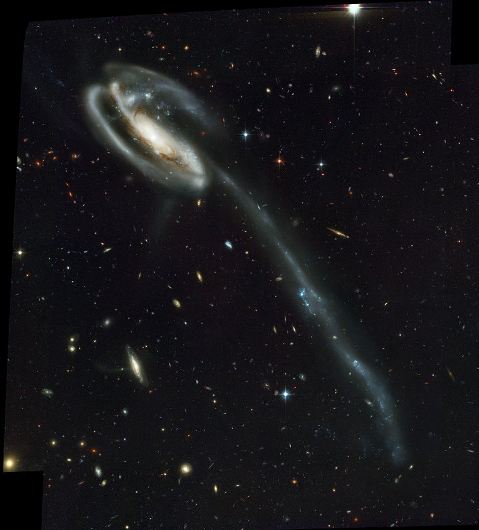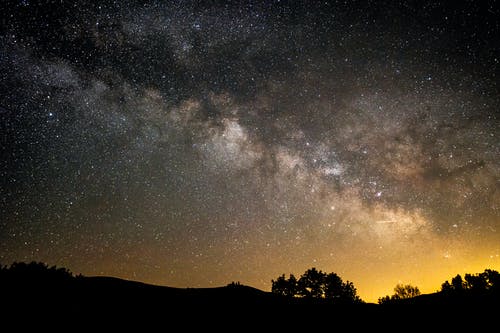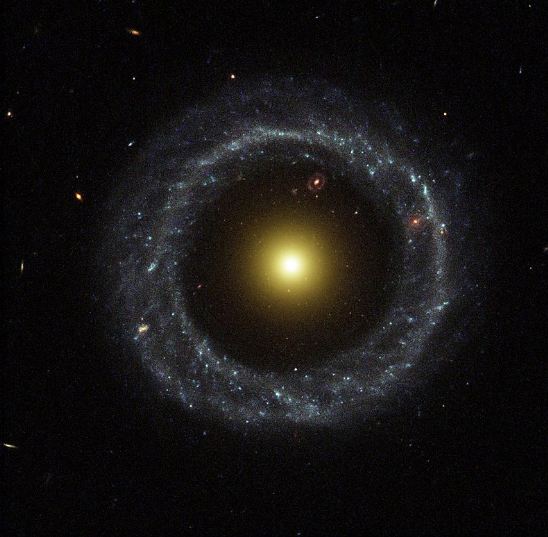Tadpole galaxy also known as UGC 10214 or Arp 188is a disrupted barred spiral galaxy located 420 million light-years from Earth toward the northern constellation Draco. Its most spectacular feature is a massive trail of bright blue star clusters approximately 280,000 light-years long, reflecting the essence of our dynamic, restless, and violent Universe. The galaxy’s size has been attributed to a fusion with a smaller galaxy believed to have occurred about 100 million years ago.
The odd-looking galaxy with the long streamer of stars looks like a runaway pinwheel firework. Astronomers hypothesized that there is a more compact galaxy that crossed in front of the Tadpole galaxy coming from the left to right from Earth’s perspective and was slung around behind the Tadpole by their mutual gravitational attraction.
While this encounter happens, the tidal forces drew out the spiral galaxy’s stars, gas, and dust, forming the conspicuous tail that makes the galaxy appears like a Tadpole. The interloping galaxy, seen shining through the galaxy’s arms, is estimated to lie about 300 thousand light-years behind the Tadpole and is visible through the galaxy’s foreground spiral arms at the upper left.
Like the terrestrial creature, the Tadpole galaxy will probably lose its tail as time passes and it grows older, the tail’s star clusters forming smaller satellites of the large spiral galaxy. The bright blue start clusters will redden with age to become in time globular clusters like those found in essentially all halos of massive galaxies, including our own Milky Way.
In the tidal tale separated by a gap, two prominent clumps of young bright blue stars are visible. Behind the Tadpole galaxy is another thousands of faint galaxies, a myriad of shapes, and represent fossil samples of the Universe’s evolution.
When can you view the Tadpole Galaxy?
Observation with the galaxy with a high apparent magnitude (14.4) requires a telescope of at least 8-10 inches. Theta Draconis is the nearest star of significance. In the northern hemisphere, the galaxy is visible throughout the whole year. It isn’t very easy to spot it in December as it is somewhere on the horizon. Since the galaxy is in one of the most northerly constellations, if you are south of Darwin, Australia, you will have difficulty seeing it. For those in the northern part of the southern hemisphere, the best time to see the galaxy is about June to September in the north direction. It will not be very high above the horizon.
HOAG’S OBJECT
In 1950, astronomer Arthur Hoag discovered a galaxy within a galaxy, a rare-ring type about a 16th-magnitude ring, tiny and faint surrounding a ball-like center, and thought to be a planetary nebula — a nearby puff of gas expelled from a single old-aged star.
To further find out the composition of his discovery, Hoag proposed an alternative and far more strange explanation that what he had seen was an “Einstein Ring” from a faraway quasar. A space-warping caused by massive foreground spherical galaxy seems to surround distorted the quasar’s light into a halo.
Spectroscopic studies rejected the idea. The central golden ball and the blue ring has precisely the same redshift, indicating they have a whopping speed of 7,916 miles/second, proof that they’re both located right at the same distance.
In 2002, Hubble Space Telescope‘s ultra-sharp optics revealed Hoag’s Object is a perfect blue ring of stars, dust, and gas, complete with knotty clumps of unresolved star clusters. It was confirmed to be another type of galaxy; however, it does have the familiar spiral pattern, with arms wending inward to the older, yellower stars that make up nearly every nucleus of the galaxies. Its core instead sits all by itself in space, 70,000 light-years away.
Where is Hoag’s Object
Hoag’s Object lies 600 million light-years in Serpens Caput constellation, the rear half of the writhing snake held by Ophiuchus the Serpent Bearer. The galaxy‘s inner yellow core is 24,000 light-years across, almost like that of the Milky Way. The outer ring has a width of 120,000 light-years, similar in size to the Milky Way galaxy’s diameter. Seemingly, an alien starship vacuumed up the middle sections of a galaxy but spared both the center and the outermost regions.
There are “ring galaxies” with a little resemblance to Hoag’s Object because their fringes are much brighter than their interiors. However, none has a ring that surrounds emptiness that, in turn, covers a giant yellow ball of suns.
Many debates surround as to how this bizarre appearance of a galaxy could have ever arisen. Idea after ideas has been proposed and then rejected. Other “classic” ring galaxies have resulted from a large disk-shaped spiral galaxy penetrated and tidally disrupted by an invading companion. Collisions either result in wild distortions as with the case M82 or the Antennae Galaxies. It can be or a merger into a new elliptical shape like that of M87.



